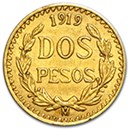
About The Mexican Peso
The Mexican gold peso is a historic currency used in Mexico from the late 19th century until the mid-20th century. Before 1959, the Mexican gold peso was made of 90% pure gold and was mainly used as a form of bullion or investment coin.The Mexican gold peso's design underwent several changes throughout its history. In the early 20th century, the coin featured the image of the Aztec emperor Cuauhtemoc on one side and the coat of arms of Mexico on the other. Later designs featured various Mexican presidents, including Venustiano Carranza and Miguel Hidalgo.
The value of the Mexican gold peso fluctuated over time and was often tied to the price of gold on the international market. During the mid-20th century, as the value of gold continued to rise, the Mexican government began to mint smaller, non-gold coins as a means of everyday currency. In 1959, the Mexican government officially replaced the gold peso with the non-gold peso, which has remained the country's primary currency to this day.
Today, Mexican gold pesos from before 1959 are highly valued by collectors and investors alike for their historical significance and intrinsic value as gold bullion. The exact value of a specific Mexican gold peso will depend on several factors, including its year of minting, its condition, and the current market value of gold.
The History Of The Mexican Peso
The history of the peso is closely tied to the history of Mexico itself, as the currency has been used in various forms since the country gained independence from Spain in 1821.The first Mexican pesos were introduced in 1823, shortly after the country's independence. These early pesos were made of silver and valued at eight reales, the standard Spanish colonial currency in Mexico. In 1863, during the French occupation of Mexico, the French introduced a new currency called the franc. Still, the Mexican government quickly re-established the peso after regaining control in 1867.
Throughout the late 19th and early 20th centuries, the Mexican peso continued to be made of silver and was used as both a currency and a form of bullion. However, with the onset of the First World War and subsequent economic instability, the peso's value began to fluctuate rapidly. To stabilize the currency, the Mexican government began to introduce a series of reforms, including establishing a central bank in 1925 and devaluing the peso in 1931.
In the mid-20th century, the Mexican government introduced a new series of currency reforms, which included the replacement of the gold peso with the non-gold peso in 1959. The non-gold peso was initially pegged to the US dollar, but over time the peso's value has fluctuated widely due to many economic and political factors.
The Mexican peso remains the official currency of Mexico and is used widely in domestic and international trade. The peso's value continues to be influenced by various factors, including global economic trends, political instability, and fluctuations in commodity prices such as oil and silver.
Today, the Mexican 50 Pesos Gold coin is among the most popular Mexican coins for collectors, prized for both its design and unique size.
Gold coins from the Banco de Mexico, like the gold Libertad, are among the top gold coins for investors. Add gold Pesos from the Mexican Mint to your collection today.
Check out what other customers are saying.
Learn More About Precious Metals
Buying Precious Metals doesn’t have to be intimidating. Whether you are making a long-term investment or simply admire the beauty of Precious Metals, APMEX provides the tools to help you make the best choice for your portfolio.
See All Articles












